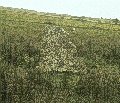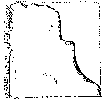It has to be noted that the stone stands at the foot of a hill with a height of 788 ft. (according to the O.S. map) which surpasses every other peak in that area.
The inscription was not readable during a first visit in 1978 because of bad weather conditions. On a second visit in 1996 the stone was quite well accessible but it has to be noted that not very many strokes have survived weathering on the edge.
Size according to Macalister, CIIC: 6'8" x 6'6" x 0'6".
Published illustrations:
Macalister, CIIC (draft).
Reading Macalister, PRIA 34, 1919, 401 (quoted by Macalister, CIIC):
OTTACI MAQ GARA ...
Reading Macalister, CIIC:
MAQ-ACTO MAQ GAR[... MAQI MUCOI Z]
Interpretation Korolev, DP, 59:
(MAQ ACTO) MAQ GAR[...
Reading Gippert (3.4.1996):
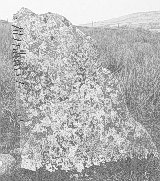 Dexter-up:
Dexter-up:
...Q...A](M)[A](QMAR)[O
...îí....â](ï)[â](îíïâòñ)[ã
...ëëëëë.......â](ï)[â](ëëëëïâïïïïïâ)[â
 bottom of the inscribed edge,
bottom of the inscribed edge, 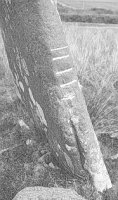 five scores can be recognized that may represent Macalister's second Q. Equally, of his "ACTO" only the last vowel notch can be made probable. In the
five scores can be recognized that may represent Macalister's second Q. Equally, of his "ACTO" only the last vowel notch can be made probable. In the  middle, it is not easy to verify Macalister's MAQ; at least, the distance between the M score and what would have to be regarded as the A dot would be extremely short; the same holds true for the first Q score (cp. figs.
middle, it is not easy to verify Macalister's MAQ; at least, the distance between the M score and what would have to be regarded as the A dot would be extremely short; the same holds true for the first Q score (cp. figs.  7 and
7 and 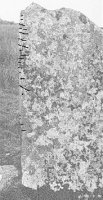 3). In the
3). In the 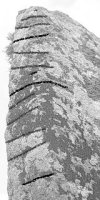 upper third of the inscription, Macalister's G cannot be verified; there seems to be just one M score. - There is no indication whatsoever in favour of Macalister's supposition that the peculiar shape of the stone might be due to a "MAQI MUCOI" formula having been intentionally destroyed.
upper third of the inscription, Macalister's G cannot be verified; there seems to be just one M score. - There is no indication whatsoever in favour of Macalister's supposition that the peculiar shape of the stone might be due to a "MAQI MUCOI" formula having been intentionally destroyed.
- PRIA 34, 1919, 401: Macalister
Last changes of this record: 14.04.97
Copyright Jost Gippert, Frankfurt a/M 1996. No parts of this document may be republished in any form without prior permission by the copyright holder.
